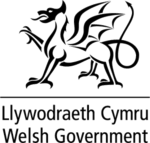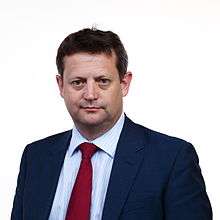Welsh Government
| Welsh Government | |
|---|---|
| Welsh: Llywodraeth Cymru | |
 | |
| Overview | |
| Established | 12 May 1999 |
| Polity | Wales |
| Leader | First Minister |
| Appointed by | Monarch |
| Main organ | Welsh Cabinet |
| Responsible to | National Assembly for Wales |
| Annual budget | £15.3 billion (2015/16) |
| Headquarters |
Crown Buildings Cardiff |
| Website | http://www.gov.wales |
The Welsh Government (Welsh: Llywodraeth Cymru) is the executive of the devolved National Assembly for Wales. The government was established in 1999 as the Welsh Assembly Government by the Government of Wales Act 1998, which created a devolved administration for Wales in line with the result of the 1997 referendum on Welsh devolution. The government consists of cabinet secretaries, who attend cabinet meetings, and ministers who do not, and also of a counsel general. It is led by the first minister, usually the leader of the largest party in the National Assembly, who selects cabinet secretaries, ministers and deputy ministers with the approval of the assembly. The government is responsible for tabling policy in devolved areas for consideration by the assembly and implementing policy that has been approved by it.[1][2]
History
1999 to 2007 (Executive Committee of the National Assembly)
 |
| This article is part of a series on the politics and government of Wales |
|
Law and justice |
|
Wales in the EU |
As initially established, the Welsh Government had no independent executive powers in law (unlike, for instance, the Scottish ministers and British government ministers). The National Assembly was established as a body corporate by the Government of Wales Act 1998 and the executive, as a committee of the assembly, only had those powers that the assembly as a whole voted to delegate to ministers.
The Government of Wales Act 2006 formally separated the National Assembly for Wales and the Welsh Government, giving Welsh ministers independent executive authority, this taking effect after the May 2007 elections. Following separation, the Welsh ministers exercise functions in their own right. Further transfers of executive functions from the British government can be made directly to the Welsh ministers (with their consent) by an Order in Council approved by the British parliament.
Separation was designed to clarify the respective roles of the assembly and the government. Under the structures established by the Government of Wales Act 2006, the role of Welsh ministers is to make decisions; develop and implement policy; exercise executive functions and make statutory instruments. The 60 assembly members in the National Assembly scrutinise the government's decisions and policies; hold ministers to account; approve budgets for the Welsh Government's programmes; and enact acts of assembly on subjects that have been devolved to the Welsh administration.
The result mirrored much more closely the relationship between the British government and British parliament and that between the Scottish Government and the Scottish Parliament.
After the 2007 election of the National Assembly for Wales
Legal separation
The new arrangements provided for in the Government of Wales Act 2006 created a formal legal separation between the National Assembly for Wales, comprising 60 assembly members, and the Welsh Government, comprising the First Minister, Welsh ministers, deputy ministers and the counsel general. This separation between the two bodies took effect on the appointment of the First Minister by Queen Elizabeth II following the assembly election on 3 May 2007.
Separation was meant to clarify the respective roles of the assembly and the government. The role of the government is to make decisions; develop and implement policy; exercise executive functions and make statutory instruments. The 60 assembly members in the National Assembly scrutinise the Welsh Government's decisions and policies; hold ministers to account; approve budgets for the Welsh Government's programmes; and have the power to enact assembly measures on certain matters. Assembly measures can now go further than the subordinate legislation which the assembly had the power to make prior to 2007.
Transfer of functions
The assembly's functions, including that of making subordinate legislation, in the main, transferred to the Welsh ministers upon separation. A third body was also established under the 2006 Act from May 2007, called the National Assembly for Wales Commission. It employs the staff supporting the new National Assembly for Wales, and holds property, enters into contracts and provides support services on its behalf.
Welsh ministers
The 2006 Act made new provision for the appointment of Welsh ministers. The First Minister is nominated by the Assembly and then appointed by Her Majesty the Queen. The First Minister then appoints the Welsh Ministers and the Deputy Welsh Ministers, with the approval of Her Majesty. The Act created a new post of Counsel General for Wales, the principal source of legal advice to the Welsh Government. The Counsel General is appointed by the Queen, on the nomination of the First Minister, whose recommendation must be agreed by the National Assembly. The Counsel General may be, but does not have to be, an Assembly Member. The Act permits a maximum of 12 Welsh Ministers, which includes Deputy Welsh Ministers, but excludes the First Minister and the Counsel General. Accordingly, the maximum size of the Welsh Government is 14.
2011 referendum on law-making powers
Functions and areas of competence
Following the "yes" vote in the referendum on further law-making powers for the assembly on 3 March 2011, the Welsh Government is now entitled to propose bills to the National Assembly for Wales on subjects within 20 fields of policy. Subject to limitations prescribed by the Government of Wales Act 2006, Acts of the National Assembly may make any provision that could be made by Act of Parliament. The 20 areas of responsibility devolved to the National Assembly for Wales (and within which Welsh ministers exercise executive functions) are:
- Agriculture, fisheries, forestry and rural development
- Ancient monuments and historical buildings
- Culture
- Economic development
- Education and training
- Environment
- Fire and rescue services and promotion of fire safety
- Food
- Health and health services
- Highways and transport
- Housing
- Local government
- National Assembly for Wales
- Public administration
- Social welfare
- Sport and recreation
- Tourism
- Town and country planning
- Water and flood defences
- Welsh language
Renaming
The Welsh Assembly Government was renamed Welsh Government (Llywodraeth Cymru) under the Wales Act 2014.[3]
Cabinet Secretaries, Ministers and Counsel General
The government is composed of cabinet secretaries and ministers. The counsel general attends cabinet meetings. The current government is formed by Welsh Labour and also the sole Liberal Democrats Assembly Member, Kirsty Williams.
Cabinet
| Office | Name | Term | Party | Image | |
|---|---|---|---|---|---|
| First Minister | Rt. Hon Carwyn Jones AM | 2009– | Labour |  | |
| Cabinet Secretary for Economy and Infrastructure | Ken Skates AM | 2016– | Labour |  | |
| Cabinet Secretary for Health, Well-being and Sport | Vaughan Gething AM | 2016– | Labour |  | |
| Cabinet Secretary for Education | Kirsty Williams AM | 2016– | Liberal Democrats |  | |
| Cabinet Secretary for Communities and Children | Carl Sargeant AM | 2016– | Labour |  | |
| Cabinet Secretary for Finance and Local Government | Mark Drakeford AM | 2016– | Labour |  | |
| Cabinet Secretary for Environment and Rural Affairs | Lesley Griffiths AM | 2016– | Labour |  | |
| Leader of the House and Chief Whip | Jane Hutt AM | 2016– | Labour |  | |
| Ministers | |||||
| Minister for Skills and Science | Julie James AM | 2016– | Labour |  | |
| Minister for Lifelong Learning and Welsh Language | Alun Davies AM | 2016– | Labour |  | |
| Minister for Social Services and Public Health | Rebecca Evans AM | 2016– | Labour |  | |
| Counsel General | |||||
| Counsel General for Wales | Mick Antoniw AM | 2016– | Labour |  | |
Civil service
The Welsh Government also includes a civil service that supports the Welsh ministers. According to a report from 2014, there are over 5,000 civil servants working across Wales.[4] The civil service is a matter reserved to the British parliament at Westminster: Welsh Government civil servants work within the rules and customs of Her Majesty's Civil Service, but serve the devolved administration rather than the British government.[5]
Permanent secretary
The permanent secretary heads the civil service of the Welsh Government and chairs the Strategic Delivery and Performance Board.
The permanent secretary is a member of the Her Majesty's Civil Service, and therefore takes part in the permanent secretaries management group of the Civil Service[6] and is answerable to the most senior civil servant in Britain, the cabinet secretary, for his or her professional conduct. He or she remains, however, at the direction of the Welsh ministers.
- Sir Jon Shortridge KCB (May 1999 to April 2008)
- Dame Gillian Morgan DBE (May 2008 to August 2012)
- Sir Derek Jones KCB (October 2012 to present)
Directorates
- Office of the First Minister & Cabinet Office
- Office of the First Minister
- Cabinet Division
- European Transition Division
- International Relations Division
- Cabinet Office
- Communications Division
- London office
- Governance & Performance
- Corporate Governance & Assurance Division
- Constitutional Affairs & Inter-Governmental Relations Division
- Corporate Services Directorate
- Welsh European Funding Office (WEFO)
- Finance
- Welsh Treasury
- Strategic Budgeting Division
- Innovative Finance
- Fiscal Strategy & Analysis Division
- Tax Policy and Legislation Development
- Office of the Chief Economist
- Legal Services
- Office of the First Minister
- Economy, Skills & Natural Resources Group
- Department of the Economy & Infrastructure
- Office of the Chief Scientific Adviser for Wales
- Transport & ICT Infrastructure Directorate
- Economic Strategy Directorate
- Sectors & Business Directorate
- Trade and Investment Division
- Tourism, Heritage & Sport Directorate
- Department of Environment & Rural Affairs
- Office of the Chief Veterinary Officer
- Agriculture, Food and Marine Directorate
- Environment & Sustainable Development Directorate
- Planning Division
- Finance and Operations Directorate
- Skills, Higher Education & Lifelong Learning Group
- National Procurement Service & Value Wales
- Department of the Economy & Infrastructure
- Education and Public Services Group
- Education Directorate
- Welsh Language Division
- Local Government Directorate
- Communities & Tackling Poverty Directorate
- Office of the Chief Digital Officer
- Housing & Regeneration Directorate
- Care and Social Services Inspectorate Wales
- Healthcare Inspectorate Wales
- Health & Social Services Group
- Health Policy Directorate
- Nursing Directorate
- Social Services & Integration Directorate
- NHS Delivery, Planning & Performance Directorate
- NHS Finance Directorate
- Mental Health, NHS Governance and Corporate Services Directorate
- Mental Health and Vulnerable Groups Division
- Substance Misuse Policy Division
- Statistical Directorate
- Office of the Chief Social Research Officer
- Digital, Innovation & Change Directorate
- Workforce & Organisational Development Directorate
- CAFCASS Cymru
Strategic Delivery and Performance Board
The Strategic Delivery and Performance Board translates the strategic direction set by the Welsh cabinet and its committees into work that is joined up across Welsh Government departments and makes the best use of its resources. The board is made up of two deputy permanent secretaries, the director-general for health and social services/NHS Wales chief executive, four directors and 3 non-executive directors, and is chaired by the permanent secretary.
Board members are appointed at the discretion of and by the permanent secretary. Membership is not wholly dependent on functional responsibilities; it is designed to provide balanced advice and support to the permanent secretary, and collective leadership to the organisation as a whole.[7]
| Position | Name |
|---|---|
| Permanent Secretary | Sir Derek Jones KCB |
| Deputy Permanent Secretary - Education and Public Services Group | Owen Evans |
| Deputy Permanent Secretary - Economy, Skills & Natural Resources Group | James Price |
| Director General, Health & Social Services and Chief Executive of NHS Wales | Dr. Andrew Goodall |
| Director, Legal Services | Jeff Godfrey |
| Director, Governance & Performance | David Richards |
| Director, Finance | Gawain Evans |
| Director, HR & Corporate Services | Peter Kennedy |
| non-executive director | Elan Closs Stephens |
| non-executive director | James Turner |
| non-executive director | Ann Keen |
| non-executive director | Adrian Webb |
Welsh Government sponsored bodies
The Welsh Government is responsible for a number of Welsh Government sponsored bodies (WGSBs). These are, respectively,
- executive WGSBs, which are non-departmental public bodies such as the Arts Council of Wales;
- advisory WGSBs, which are non-departmental public bodies such as the Historic Buildings Council for Wales; and
- tribunals such as the Mental Health Review Tribunal for Wales.
WGSBs are staffed by public servants rather than civil servants.
The Welsh Government is also responsible for some public bodies that are not classed as WGSBs, such as NHS Wales, and the Welsh Offices of England and Wales legal offices.
Offices
The Welsh Government has a total of 35 offices across Wales,[8] with a number in London and overseas.[9] Historically, most Welsh Office staff were based in Cardiff, especially in Cathays Park. However, in 2002, the Fullerton Review concluded that "the Assembly could no longer sustain having the majority of its operational functions located in and around Cardiff".[10] Since 2004, Welsh Government civil servants have been relocated across Wales as part of the Location Strategy, which involves the creation of new offices at Merthyr Tydfil, Aberystwyth and Llandudno Junction.[11] In 2006, the mergers of ELWa, the Wales Tourist Board and the Welsh Development Agency into the Welsh Government brought these agencies' offices into the Welsh Government estate.
The office of the First Minister is in Tŷ Hywel and the Senedd in Cardiff Bay; an office is also kept at the Welsh Government building in Cathays Park where the majority of Cardiff-based Welsh Government civil servants are located.
- The old Crown Building in Cathays Park – original home of the Welsh Office
 The New Crown Building is today home to many of the Welsh Government's civil servants
The New Crown Building is today home to many of the Welsh Government's civil servants Tŷ Hywel houses the offices of the cabinet
Tŷ Hywel houses the offices of the cabinet
Budget
The Welsh Government receives a budget allocation from the UK Government[12] determined by the Barnett Formula.
List of successive Welsh Governments
See also
References
- ↑ "Welsh Government: a quick guide" (PDF). Welsh Government. 2015. Retrieved 13 January 2016.
- ↑ "Welsh Government: about". Welsh Government. 2016. Retrieved 22 May 2016.
- ↑ "Welsh assembly report damns Cardiff government for failure to cut poverty". The Guardian website. Guardian News & Media. 19 June 2015. Retrieved 15 January 2016.
- ↑ "Welsh Government Civil Service". Welsh Government. 31 March 2014. Retrieved 13 January 2016.
- ↑ "Welsh Government civil service: how we work". Welsh Government. 11 November 2013. Retrieved 13 January 2016.
- ↑ Civil Service. PSMG Membership
- ↑ Welsh Government | Membership. Wales.gov.uk (2013-03-18). Retrieved on 2013-08-24.
- ↑ "State of the Estate Report 12/13". Welsh Government. 2013-10-31. Retrieved 2013-12-31.
- ↑ Welsh Assembly Government | All offices
- ↑ Welsh Government | Update on Location Strategy
- ↑ Welsh Government | Location Strategy
- ↑ Welsh Government | Budgets. Wales.gov.uk (2013-07-08). Retrieved on 2013-08-24.
External links
- Website of the Welsh Government
- Welsh Government Ministers
- Government of Wales Act 2006 website
- Law Wales Website – Home
